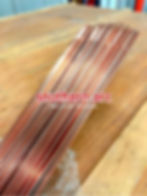Exploring the Differences between ER70S-6 and ER70S-2 TIG Welding Wire
- Luis Alejandro
- Apr 5, 2023
- 2 min read
Updated: Jun 24

When it comes to TIG welding, selecting the right filler metal is crucial for achieving strong, clean, and high-quality welds. Two commonly used options for mild steel are ER70S-6 and ER70S-2. While they may seem similar at first glance, each has distinct properties that make it better suited for specific welding conditions.
ER70S-6 TIG Welding Wire
ER70S-6 is a mild steel filler wire known for its high levels of silicon and manganese. These elements help it combat mill scale, rust, and other surface impurities on the base metal, making it a more forgiving option for less-than-pristine welding surfaces.
Key Features:
Excellent for welding mild and low-alloy steels
Works well on rusty, oily, or dirty surfaces
Produces a smooth, stable arc with good puddle control
Ideal for automotive, structural, and fabrication work
Popular among beginners for its ease of use
Because of its strong deoxidizing capability, ER70S-6 provides solid welds even in environments where surface prep isn’t perfect.
ER70S-2 TIG Welding Wire
ER70S-2 also meets the same mechanical specs as ER70S-6 but has a different formulation of deoxidizers, including aluminum, titanium, and zirconium. These help control impurities that may be present within the metal rather than just on the surface.
Key Features:
Best used on clean, prepared base metal
Ideal for thin materials, like sheet metal and tubing
Produces precise, high-quality welds
Excellent puddle control and arc stability
Often used in aerospace, tube welding, and other precision applications
While it’s not as forgiving with dirty surfaces as ER70S-6, ER70S-2 shines when the base metal is clean and you need tight control over the weld quality.
Choosing Between ER70S-6 and ER70S-2
Factor | ER70S-6 | ER70S-2 |
Base Metal Condition | Tolerant of rust and mill scale | Requires clean surfaces |
Material Thickness | Better for thick materials | Better for thin materials |
Welding Position | Flat and horizontal preferred | Suitable for all positions |
Arc Characteristics | Strong, stable arc | Softer arc with precise control |
Deoxidizers | High silicon and manganese | Multiple complex deoxidizers |
Common Use Cases | Structural, automotive, general repair | Precision welding, tubing, aerospace |
Tensile Strength | 70,000 psi (same as ER70S-2) | 70,000 psi (same as ER70S-6) |
Final Thoughts
Both ER70S-6 and ER70S-2 are excellent choices for TIG welding mild steel. ER70S-6 is versatile, beginner-friendly, and great for general fabrication. ER70S-2, on the other hand, offers better control for thin and clean metals in more precise applications. The best choice comes down to your specific project needs, including the condition of your base metal, its thickness, and the level of weld precision required.
Because of its strong deoxidizing capability, ER70S-6 provides solid welds even in environments where surface prep isn’t perfect.
Check out our other blog posts here https://www.southernarc.org/blog
About the author: Luis Alejandro is the owner and one of the instructors at Southern Arc Welding Services Ltd. Co.. He enjoys family, reading books on history, and writing to share his knowledge about the many situations welding can place us in.